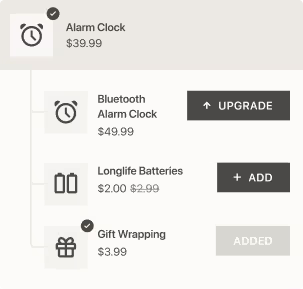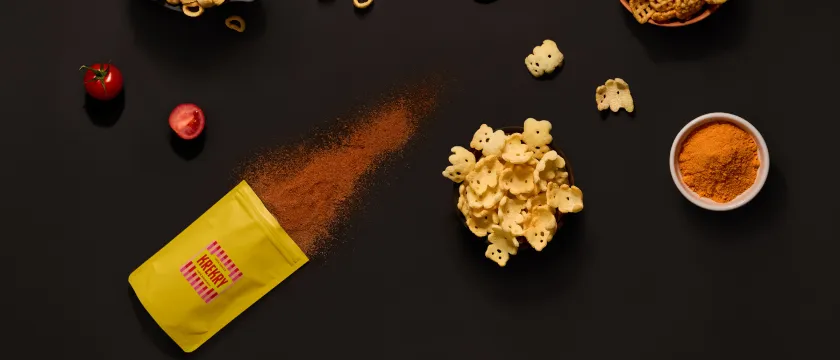Product bundling is a type of upselling where you offer a set of items logically combined together.
It’s a great way to grow your store because it allows you to:
- Increase the AOV. When customers initially had the intention to only buy an individual product but then saw the benefits of buying a bundle, they bring you a higher order value, which is essential for business growth.
- Reduce marketing and fulfillment costs. When you sell the products included in a bundle separately, you’re spending more on processing each individual order, packing, and delivering it. While selling a bundle at once improves your unit economics and cuts the costs associated with promoting included items, storing them, and shipping them to customers.
- Introduce new products to customers. Product bundling is also a means to highlight new arrivals. For example, you can feature new product samples in best-selling bundles, giving customers an opportunity to try something new and return to your store if they like it.
- Battle overstocking. Having too much stock is just as big of a problem as not having enough. By creating product bundles, you can put the slow-moving stock to better use and improve your inventory management.
- Highlight seasonal promotions. In some e-commerce niches, bundles naturally fit the idea of seasonal offers. Don’t miss an opportunity to create various product sets dedicated to a certain occasion or season.
- Boost loyalty. When customers acknowledge the value of a product bundle, they are more likely to return to your store. Your bundles shouldn’t look like you just need more items to be sold—they should provide clear benefits to customers. Explain how the added products work together, how much a person saves, etc.
Types of bundles
How to bundle products very much depends on what you’re selling and how you want to engage your customers. The major types of product bundles include:
- Pure bundles. These are pre-defined sets of products that can’t be sold separately. In most cases, it’s not a recommended technique. The notorious case of Nintendo showed that the same products performed well when available both in a bundle and individually but led to a 20% revenue decrease when not offered outside of a bundle.
Even if products are used inseparably, give customers a choice to buy them separately or together, and highlight the benefits of the bundle. For instance, a store selling beach umbrellas has anchors and umbrellas themselves as separate items even though it makes sense to buy a bundle in most cases:

- Cross-sell offers. These bundles feature products that are normally used together. Mixing a camera with a camera strap or rolls of film is a nice example.
Learn more about successful cross-selling strategies from our post.
- BOGO offers. BOGO (Buy One Get One Free) means offering the same item (or the same type of items) with a discount when a customer purchases two or more of them.
According to a survey by AMG Strategic Advisors, a whopping 93% of consumers prefer BOGO offers to other types of promotions. BOGO is a nice strategy for products that are in regular use (food, body care, pet supplies, etc.).
- Gift sets. Product bundles can serve as perfectly shaped gifts. In this context, the most valuable will be not the discounted price of included products but the way those products are selected and presented to a customer.
- Occasional bundles. Similarly to gift bundles, the ones dedicated to a certain occasion can attract customers looking for gift ideas or those who like to browse and shop for fun.

- Subscription bundles. With these offers, you can hook customers for months ahead. The subscription model might work well with bundling and can help you promote new products.

- Custom bundles. This type of bundling allows customers to choose what products to include. You can go with different strategies: list all relevant items on a bundle page, provide a multi-step process of creating a bundle, etc. Customization here is practically endless: you can allow customers to choose packaging or personalize products.
Here’s an example of how to create a bundle that customers can personalize:

8 tips for high-converting product bundles
Now that you know about the different types and purposes of bundles, let’s discover how to create a bundle that will win customers over and boost your conversion rates.
1. Combine fast-selling products with slow-moving ones
With product bundles, you’re feeding two birds with one seed: first, you can deal with slower inventory and avoid the risk of dead stock, and second, you can help people discover bests-sellers that they might have missed.
Identify the most revenue-boosting and the most stagnating items by calculating the stock to sales ratio. Based on the findings, think of how you can match some of the former products with some of the latter ones.
However, don’t mix products based on their popularity only. Before anything else, your bundles should be relevant and helpful.
2. Think of a fun name for your bundles
Make your product bundles attractive, in the way you name them as well. Get creative instead of using generic names like “House cleaning bundle” or “Dog treat bundle.”
For example, who wouldn’t want to buy a set of products titled “You deserve it all”?

3. Be specific about the bundle’s benefits
Promote product bundles as a way to solve a specific problem or celebrate something special. Explain what’s included, how it’s used together, and why it’s beneficial to a customer.
It’s especially important to break down the price and inform how much a person can save by purchasing a bundle. Here’s an example of product bundle pricing explained:

You can visualize cost savings both in bundle descriptions and on individual product pages. With the latter option, you can promote bundles that include this product and clearly indicate the price difference (like “Save 20%”).

4. Create time-limited deals
By making your offers limited in time, you can create a sense of urgency in shoppers and motivate them to hurry up with their purchasing decisions. For instance, you can put an additional discount on a product bundle.

5. Display bundle offers at multiple stages of the buyer’s journey
There are different ways you can present bundled products. If you want to make them a permanent part of your store’s structure, you can add them as a separate category and feature them in the header menu.

Or even dedicate a whole section on your homepage to bundles:

For some types of bundles like BOGO or subscriptions you can either have each offer presented in the catalog or only show them as options on the main product page. In the example below, the BOGO bundle naturally fits the product page as one of the options to extend the purchase:

Besides, you can adopt soft cross-selling to feature bundles as popular products or add an interactive section below a product description that includes relevant additions. In the example below, people visiting the mud mask page can add bath crystals and salt stones in one click, as well as quickly view the details of suggested products and select or unselect any of them:

You can also leverage product bundling during or even after the checkout. Give customers an idea of what they can add and inform them how they can save on the offer and benefit from it.
Our Last Upsell app allows you to add post-purchase cross-sells, and you can position them as bundled products as well.
6. Bring attention to your bundles across social media channels
If you’ve created a perfect product bundle, spread the word about it. Social commerce might be an effective way to promote your offers—for instance, videos that showcase the benefits of bundles gain significant traction on TikTok. By cooperating with influencers or creating your own video content, you can engage with the audience, answer their questions and concerns, and as a result, get more sales.

7. Sync inventory
It’s important to keep track of inventory levels of items included in bundles. The more products are bundled, the more different points of inventory data you need to sync. If a single item gets out of stock, then a whole bundle shouldn’t be shown as available.
If you’re using bundle apps or plugins on your store, they will normally sync your inventory automatically. If you have a manually created bundle, make sure to track stock movement of all products and set low-stock alerts.
8. Never stop analyzing customer data
The key to successful product bundles is understanding consumer needs and purchasing patterns. Regularly analyze what items perform best and among which customer segments, what items are often left in abandoned carts, what products get substantial traffic but no sales, etc. This will help you create data-driven bundles that attract shoppers by predicting and addressing their needs, giving them added value, and exciting them.
Bundle up!
Product bundling opens up multiple ways for you to grow your e-commerce business. It can help increase the AOV and customer loyalty, as well as better distribute inventory and avoid dead stock. We hope these tips will help you set up an effective bundling strategy and gain more satisfied customers.
















